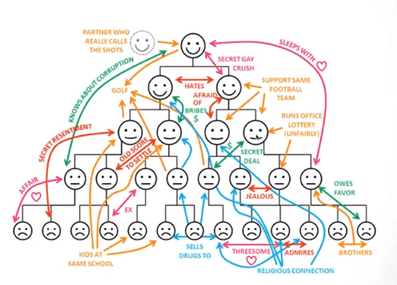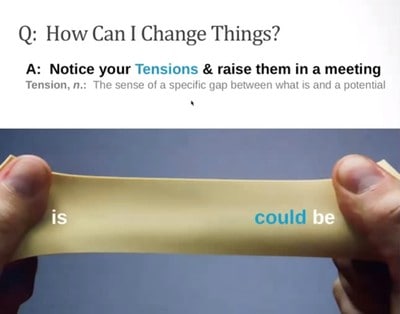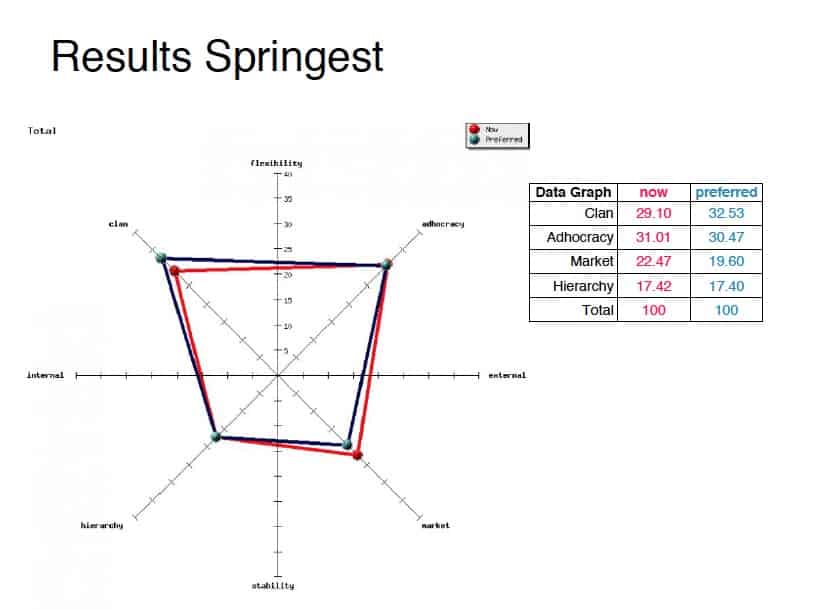What are the challenges of organizational life? Your answer may contain silos, lack of trust, lack of decision making, politics, bureaucracy, communication issues, overwhelm, difficulty with change, rigidity and more… “Organizations are designed to produce these painful results!” That’s why Brian Robertson invented “Holacracy”. Does that work any better? I checked in with Ruben Timmerman of Springest to find out.
“Everywhere in the world, I hear these same answers. Big, small, profit or not-for-profit organizations suffer. Why haven’t we solved this yet? Think of the human and economic cost!” says Brian Robertson. “Organizations are designed to produce these painful results; the power structure itself creates these unintended consequences.”
It was 2001 when Robertson decided there must be a better way of running an organization. “Order doesn’t require a boss.” He used his own company as a laboratory and built and crafted “Holacracy” – after years of trial and error. Since 2007 Robertson spreads this organizational system all over the world, supporting organizations to implement it and selling the software to smoothly run Holacracy. Now that famous companies such as Zappos have adopted it, the method is becoming famous…
Springest gets peace of mind
Holacracy is an operating system for organizing. “Compare it to your smartphone”, says Ruben Timmerman, a Dutch entrepreneur who adopted Holacracy for his company Springest. “With the operating system you can install any app on your smartphone – or delete it again. That’s Holacracy. You can create anything and change anything all the time – playing by the rules of the Holacracy operating system.”
Springest is an online platform where vendors can offer their onsite or online workshops, training, retreats and development programs. Visitors can enroll through Springest and rate the training on offer. The start-up doubled in size last year and grew rapidly from 15 to 30 employees. Their aim is to become “the Amazon.com of learning”.
 Timmerman was too busy all the time while all he wanted was peace of mind. He attended a Getting Things Done training by David Allen and discovered Holacracy because David Allen’s company is using it, too. “You lose something when you grow”, says Ruben. “I was prepared to let go of control (which is an illusion anyway 😉 and to get rid of the details on my to-do list IF I could trust the system. That was my condition. Holacracy creates a game field of accountability – so I can trust the system.”
Timmerman was too busy all the time while all he wanted was peace of mind. He attended a Getting Things Done training by David Allen and discovered Holacracy because David Allen’s company is using it, too. “You lose something when you grow”, says Ruben. “I was prepared to let go of control (which is an illusion anyway 😉 and to get rid of the details on my to-do list IF I could trust the system. That was my condition. Holacracy creates a game field of accountability – so I can trust the system.”
CEO: no longer above the law
Holacracy-founder Robertson explains that getting the CEO to accept Holacracy and to help him or her let go of “total control” can be difficult. “Holacracy is a rule system. The CEO must adopt it. If he agrees to be bound by it, he’s no longer above the law. The power is held by the Holacracy constitution until proven it doesn’t work. Everyone must follow the rules to engage with each other. It’s a big shift when employees say: Wait – you don’t have the authority to make that decision anymore, dear CEO…!”
The key elements of Holacracy are:
1. We organize the work, not the people. Don’t put people in units on a fixed organizational chart.
2. We have a Governance Process that distributes authority and creates clarity of what to expect of one another.
3. We have operations: that include tactical meetings to align and to do triage.
How many hats do you wear?
In Holacracy, people don’t have jobs with job descriptions. They have different roles to fulfill in different circles – like anyone in life: we all wear many hats in different groups with varying purposes. Role definitions have accountabilities; making explicit what is expected of each role.
 A role gives you authority (as long as you don’t violate other’s roles). You can make the decision that you think is useful to achieve your role’s purpose. It’s not consensus: it’s autocratic authority, to decide how to get your work done – there is no manager to trump your decision. Everyone has this autonomy within the limits of their role. But of course, your colleagues can ask for transparency because you are accountable.
A role gives you authority (as long as you don’t violate other’s roles). You can make the decision that you think is useful to achieve your role’s purpose. It’s not consensus: it’s autocratic authority, to decide how to get your work done – there is no manager to trump your decision. Everyone has this autonomy within the limits of their role. But of course, your colleagues can ask for transparency because you are accountable.
The roles are created and distributed in the governance process. The work is divided in circles, and each circle has a “lead link”. The lead assigns the roles to circle members. Everyone in the circle can attend the governance meetings – where everything can be changed again – playing by the rules.
Ruben Timmerman likes this clear accountability. He’s very results-oriented and likes getting things done. Holacracy gives Springest just that. “Getting to know the game takes more time upfront for new hires – but you win it back in results, once people get the hang of it,” he says. “It’s transparent. It’s also continuous change – by default. Anyone who wants to change something can propose so in a governance meeting – we have them every two weeks.”
 In Holacracy jargon, problems, and opportunities are “tensions”; a gap between what is and what could be. People are responsible for bringing up their tensions in the governance meeting and solving them. “Even if the others may have some objections, eventually, the person with the tension can try and solve it according to his plan. In 2 week’s time, we have the next governance meeting so we can change his plan again – and see if and how it worked out”, explains Ruben. “I don’t always agree with the solutions brought up. But it’s not my call anymore. People decide and we’ll see what happens – they are accountable for the results. I like this system – even though it’s sometimes a little too slow for me. How well the Holacracy game is played still depends on the people you work with. If you’re too shy to give your opinion, if you’re too hesitant to decide, if you’re scared about your responsibilities, then it doesn’t work great. It’s a tool. You can’t get angry at the hammer when it doesn’t build a house. You have to use the tool.”
In Holacracy jargon, problems, and opportunities are “tensions”; a gap between what is and what could be. People are responsible for bringing up their tensions in the governance meeting and solving them. “Even if the others may have some objections, eventually, the person with the tension can try and solve it according to his plan. In 2 week’s time, we have the next governance meeting so we can change his plan again – and see if and how it worked out”, explains Ruben. “I don’t always agree with the solutions brought up. But it’s not my call anymore. People decide and we’ll see what happens – they are accountable for the results. I like this system – even though it’s sometimes a little too slow for me. How well the Holacracy game is played still depends on the people you work with. If you’re too shy to give your opinion, if you’re too hesitant to decide, if you’re scared about your responsibilities, then it doesn’t work great. It’s a tool. You can’t get angry at the hammer when it doesn’t build a house. You have to use the tool.”
Dynamic and structured in one
Holacracy is an operating system for the organization. But you have to fill it yourself and create the typical “apps” that fit your workplace. You can work out how to appraise people, how to assess their skills, how to do performance reviews, how to fire people, how to renegotiate and distribute roles etc. Every organization can decide for themselves. The beauty is that Holacracy doesn’t prescribe the contents. Robertson: “It’s very dynamic, everything is negotiable in governance meetings. But it is also structured, with a clear set of playing rules.”
Those two competing values, dynamic and structured at the same time, are an interesting mixture. That’s why I offered Springest a check on their organizational culture: what would that look like? (In addition to writing this blog, I am a change consultant who works with organizational culture – MB). Using the Organizational Culture Assessment Instrument (OCAI), developed by Cameron & Quinn, Springest mapped their current and desired organizational culture on the Competing Values Framework.
The OCAI distinguishes four archetypes of culture: the dynamic, entrepreneurial Adhocracy culture, the people-oriented, friendly Clan culture, the process-oriented, structured Hierarchy culture and the results-oriented, competitive Market culture.
 Springest’s culture turns out to be very balanced. “I recognize us – and I like the outcome,” says Sofie Angevaare, Springest’s PR role. “No extremities but a nice mixture of all four culture types. And it’s good to see that we seem satisfied with how we work – because there’s hardly any difference between the graphs of current culture (red) and preferred culture (blue).”
Springest’s culture turns out to be very balanced. “I recognize us – and I like the outcome,” says Sofie Angevaare, Springest’s PR role. “No extremities but a nice mixture of all four culture types. And it’s good to see that we seem satisfied with how we work – because there’s hardly any difference between the graphs of current culture (red) and preferred culture (blue).”
Founder Ruben Timmerman is not surprised to see these results either but does think the organization could aim for a bit more results-oriented market culture in the future…
 Fact is, their culture profile is extremely well balanced. The dynamic Adhocracy culture score of 31 points is one of the highest I’ve ever seen. Many organizations don’t do so well in this creativity & innovation culture type.
Fact is, their culture profile is extremely well balanced. The dynamic Adhocracy culture score of 31 points is one of the highest I’ve ever seen. Many organizations don’t do so well in this creativity & innovation culture type.
Their Hierarchy scores are a bit lower than I’d expected, based on the rules of Holacracy and the sound of the word “governance meeting”. Most organizations score much higher on Hierarchy than Springest with their 17 points. But everyone seems to feel fine with the “loose structure” of Holacracy – leaving room for lots of flexibility in the upper culture types of the framework.
The people orientation of 29 Clan culture points and the results focus of 22 Market culture points are nicely poised. It’s both people-oriented and participative as well as results-oriented and competitive.
The culture profile shows that Springest employees seem content, working in a Holacracy (because current and preferred culture are almost the same). Brian Robertson is right: it is dynamic and structured at the same time.
Organizational politics?
 But Holacracy gives no guarantees for peak performance and pleasure at work –it depends on how people use the tool. People will be people… So, how do you get rid of politics? “You can’t outlaw politics,” thinks Robertson. “People use politics because it’s useful to get their desired results and influence others. Holacracy doesn’t stop politics – but you have influence in governance meetings. It’s easier to make a proposal. You don’t need politics like in a standard hierarchy – as the only way to get things your way. It’s a learning process. Politics will phase out because you don’t need them in Holacracy – where everyone has autonomy.”
But Holacracy gives no guarantees for peak performance and pleasure at work –it depends on how people use the tool. People will be people… So, how do you get rid of politics? “You can’t outlaw politics,” thinks Robertson. “People use politics because it’s useful to get their desired results and influence others. Holacracy doesn’t stop politics – but you have influence in governance meetings. It’s easier to make a proposal. You don’t need politics like in a standard hierarchy – as the only way to get things your way. It’s a learning process. Politics will phase out because you don’t need them in Holacracy – where everyone has autonomy.”
He adds: “In the same way, you don’t need to lean on personal likes and dislikes (love and kindness) to get things done, or to get favors. In Holacracy, everyone’s responsibilities are very clear.” And that’s exactly what Ruben Timmerman likes about it.
Last but not least, Robertson warns against doing part of Holacracy as a ”recipe for disaster”. You have to adopt it completely. “You can adopt all the rules and then play at a 6-year-old level just like soccer. It takes time before you are a Pro and become better in playing the game.” Ruben and his team are continuously developing themselves in the game. “Our current level is 60%,” estimates Ruben. “100% perfection is not possible in this world – but we are learning and getting better all the time.” Keep up the good work, Springest!
Ruben Timmerman founded Springest.com and Springest.co.uk
Brian Robertson founded https://www.holacracy.org/ – a complete system for self-organization.
Marcella Bremer is an author and culture & change consultant. She co-founded this blog and OCAI online.
One Response
Awesome !!! HOLACRACY really means making the organization as ONE FAMILY, holistically, to reach the goals beyond boundaries, by continuously adding values to the society and truly delighting every member of the whole family, directly or indirectly contributing the growth of the organization. Holacracy will soon change the dynamics of the existing management systems, policies & values…Light the Inner light;